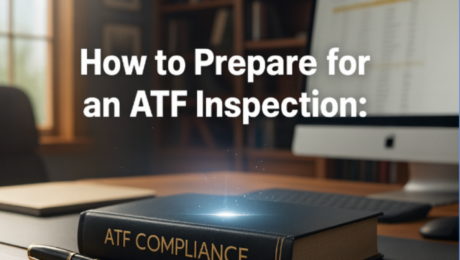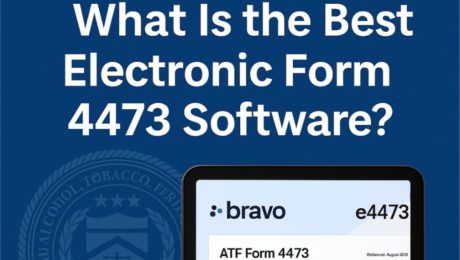The ATF Form 4473, officially the Firearms Transaction Record, is the backbone of every legal, over-the-counter firearm sale in the United States. For both the Federal Firearms Licensee (FFL) and the buyer (transferee), completing it accurately is non-negotiable. Yet errors remain common. A single mistake on a paper ATF Form 4473 isn’t just a minor inconvenience that halts a transaction; it represents a significant compliance failure that puts your entire business at risk. During a routine ATF compliance inspection (audit), such errors can result in Financial Penalties, License Jeopardy. It’s critical to have a good defense against penalties and license revocation. So what’s the biggest culprit behind these compliance headaches? The Biggest Cause: Incomplete or Inconsistent Information in Section A While dealer-side errors in Sections B and C can lead to more serious violations, the majority of form rejections begin in Section A ,the portion completed by the buyer. Most issues stem not from intent but from inconsistency or inattention. Even small variations between the buyer’s written information and their photo ID can cause mismatch and administrative rejection. 1️⃣ Inconsistent Residential Address (Box 10) This is the top cause of administrative delays. The ATF requires the transferee’s current physical residential address to be listed in Box 10, and it must match the address on the government-issued photo ID presented to the FFL. The Common Error: A buyer writes their current address, but their ID still lists an old address. Or, they add “Apt. 2B” while their ID shows only “2B.” Even small discrepancies can trigger a rejection, requiring the buyer to provide additional proof (such as a vehicle registration or utility bill). 2️⃣ Misinterpreting the “Prohibited Person” Questions Section A also includes questions about a buyer’s legal eligibility to possess firearms (21.b, 21.g, 21.i, 21.j, etc.), covering felony convictions, restraining orders, unlawful substance use, and more. The Common Error: Buyers may misread these legal definitions. For example, assuming a dismissed charge doesn’t apply when it legally does. Incorrectly marking “No” where the correct answer is “Yes” (or vice versa) can constitute a felony and lead to a NICS denial. 3️⃣ Missing Dates, Signatures, or Checkmarks Every box on the Form 4473 has legal significance. It’s common for buyers to forget to check a box, skip the date (Box 18), or miss the signature (Box 19). The FFL cannot continue the transaction until every required field is completed correctly. ✅ How to Prevent 4473 Errors For Buyers: Bring a Current ID: Ensure your driver’s license or government ID matches your current physical address. If not, bring a supplemental document that proves residency. Read Carefully: Review each question closely. If you’re unsure, ask the dealer before answering. Double-Check Everything: Verify every “Yes” or “No,” date, and signature before submission. For Dealers: Verify ID Accuracy: Confirm the photo ID matches the buyer and that the address aligns with the entry in Box 10. Review Section A: Before completing your portion, check for consistency and completeness. Log Details Correctly: Record the NICS check date/time, result, and disposition information immediately. 💡 How Bravo Store Systems Helps Bravo’s E4473 eliminates these manual risks by guiding the process digitally: Validation at Entry: Buyers can’t skip required boxes or sign before all mandatory fields are completed. Automated Logic: Bravo’s Ee4473 applies ATF rules at every step, ensuring required documentation (like proof of residency) is entered correctly. Digital Accuracy: No handwriting errors, no missing checkboxes, and no unreadable entries. Retention to Spec: All digital 4473s are stored securely per ATF Ruling 2022-01, ensuring 20-year retention with audit-ready accessibility. Result: Fewer corrections. Faster transactions. Complete peace of mind for your FFL. 🎯 Ready to Eliminate 4473 Errors for Good? See how Bravo Store Systems E4473 helps FFLs stay accurate, compliant, and audit-ready 24/7. 👉 Request a 15-Minute Demo Today
For every Federal Firearms Licensee (FFL), an inspection by the Bureau of Alcohol, Tobacco, Firearms and Explosives (ATF) is part of doing business. An ATF inspection isn’t meant to punish—it’s meant to check that your records and processes follow federal rules. The best defense? Be audit-ready 24/7, not just when the inspector calls. 🔑 Key Takeaways Technology reduces errors: Digital A&D and electronic 4473 systems reduce the mistakes that create violations. Compliance is daily: Your A&D book must be accurate at the end of every business day. Training matters: Every employee who handles firearm paperwork must know the rules and your SOPs. Inspectors focus on four areas: A&D book, 4473s, inventory security, and background check procedures. 1️⃣ Keep a Clean and Accurate A&D Book Your Acquisition & Disposition (A&D) book is the first thing an ATF inspector checks. Every firearm must be logged accurately at the moment it is received or transferred. Record acquisitions and dispositions immediately. Make sure entries are complete, legible, and in the correct order. Review your A&D book daily to confirm everything is up to date. Even small gaps or delays can cause violations during an inspection. 2️⃣ Ensure Every Form 4473 Is Correct The ATF Form 4473 documents every firearm sale. Errors here are one of the most common inspection findings. Check that every required field is answered. Confirm that the buyer’s ID matches the information in Section A. Make sure dates, signatures, NICS details, and disposition information are accurate and complete. Keep all 4473s organized and accessible for the full retention period. A quick review before filing can prevent the most common issues. 3️⃣ Reconcile and Secure Your Inventory Inspectors compare a sample of your physical inventory to your A&D book. Regularly perform internal audits by scanning inventory and comparing them to your records. Investigate any mismatches right away. Report missing or stolen firearms immediately to ATF and local law enforcement and document the event. Keep storage areas secure with proper locks, alarms, and surveillance. Staying proactive prevents surprises during inspection. 4️⃣ Train Your Staff and Follow SOPs Compliance is a team effort. Make sure every employee understands your store’s procedures for logging firearms, running transfers, and completing forms. Train new employees and provide refresher classes for current employees. Keep written SOPs that explain exactly how each process should be handled. Maintain training records—inspectors may ask to see them. Clear, consistent processes reduce mistakes. 5️⃣ Managing the On-Site Inspection When the inspector arrives, staying organized and professional goes a long way. Designate one Responsible Person to communicate with the inspector. Provide a clean workspace and quick access to records. Stay calm and answer questions directly. Review any findings in the Report of Violations and document how you will correct them. A well-run inspection shows your business takes compliance seriously. 🧭 Conclusion: Daily Habits Create Audit Confidence Preparing for an ATF inspection isn’t about last-minute scrambling—it’s about following the right processes every day. Accurate A&D entries, complete 4473s, consistent training, and organized records are what keep your FFL protected year-round. This daily discipline is even easier with the right tools. Bravo Store Systems helps FFLs stay audit-ready by digitizing 4473s, enforcing required fields at entry, maintaining secure digital retention, and keeping the A&D book accurate as you work. Stay confident. Stay compliant. Stay ready—every day. 👉 See How Bravo Keeps FFLs Audit-Ready 24/7 Request a 15-Minute Walkthrough
For any Federal Firearms Licensee (FFL), the ATF Form 4473 is the most critical compliance document. Unfortunately, errors on paper forms—missing fields, illegible handwriting, or incomplete responses—remain among the top violations cited by the ATF every year. Moving to a digital ATF eForm 4473 system isn’t just about saving paper. It’s about strengthening compliance by reducing manual errors, enforcing accuracy, and making your store audit-ready 24/7. Here’s how an e4473 solution helps FFLs proactively prevent violations and safeguard their operations. 1️⃣ Reducing the #1 Violation: Missing or Incomplete Information Paper forms are prone to simple but costly mistakes. A digital e4473 system ensures accuracy and completeness before the form can be finalized. Guided Workflow: Customers complete every required field on a tablet or computer. The form cannot be submitted or digitally signed until all mandatory fields are filled in correctly. Built-In Validation Logic: The software follows ATF rules to guide responses. For instance, if a customer indicates “Yes” to being a non-U.S. citizen, the system automatically prompts for additional documentation and relevant follow-up questions, reducing the risk of omissions. Instant Error Alerts: If an entry doesn’t match the expected format (like an invalid ID number), the system flags it immediately—so corrections happen before submission, not after inspection. Bravo Note: Bravo’s E4473 validates every field at entry and enforces completion before saving, helping eliminate omissions and improve inspection outcomes. 2️⃣ Reducing Risk Around Prohibited Transfers While the NICS check determines eligibility, incomplete or mishandled 4473 data can still create compliance exposure. Review Prompts: Many e4473 solutions, including Bravo’s, surface mandatory review prompts when customers answer “Yes” to disqualifying questions—This ensures the FFL verifies each case before transferring a firearm. Automatic NICS Tracking: Bravo’s E4473 automatically records the date and time the NICS check was initiated and the final response, preventing one of the most common recordkeeping violations: missing or inaccurate NICS contact information. 3️⃣ Strengthening Record Retention and Trace Response Compliance doesn’t stop at the point of sale. Paper forms must be securely retained for 20 years, which introduces physical risk and retrieval delays. Digital Record Protection: Electronic storage protects records from loss, fire, water damage, and deterioration. Bravo’s E4473 retention follows the ATF rRules ensuring data redundancy, security, and retrieval standards are met. Fast Trace Requests: With digital retention, FFLs can search by serial number, customer name, or transaction date in seconds. When ATF requests a trace, a process that once took hours can now take minutes—improving both efficiency and compliance confidence. ✅ The Bottom Line: Proactive Compliance, Not Reactive Fixes Switching to an electronic 4473 system moves your FFL from a reactive position—fixing errors after they’re found—to a proactive one that prevents mistakes before they occur. It saves hours of manual audit prep, reduces violations, and gives your staff more time to focus on what matters most: customers and sales. 👉 See How Bravo E4473 Works Learn how Bravo Store Systems helps FFLs stay confident, compliant, and audit-ready every day. [Request a 15-Minute Walkthrough]
When it comes to firearm sales, compliance is everything. Every Federal Firearms Licensee (FFL) knows that even small mistakes on the ATF Form 4473 can lead to costly violations or delays. That’s why thousands of dealers are switching from paper forms to digital workflows. The most complete and trusted solution available today is Bravo Store Systems E4473 — a secure, easy-to-use system that keeps your store audit-ready 24/7. Why Bravo’s E4473 Is the Gold Standard for Compliance Bravo’s E4473 isn’t just an online form. It’s part of a complete digital compliance system that connects every step of your operation — from sales to record retention — in one place. ✅ 1. Digital Done Right — Faster, Cleaner, Audit-Ready Bravo’s E4473 isn’t just a digital version of a paper form — it’s a complete compliance upgrade. Every form is legible, automatically stored, and linked directly to your A&D Bound Book. When a trace request comes in, you can find the firearm, pull the attached 4473, and send the record in minutes — no more digging through boxes or handwritten forms. Every step — from customer entry to final signature and digital storage — is paperless, organized, and audit-ready 24/7. 🔗 2. Built Into the Bravo POS System Bravo’s E4473 is natively integrated with the Bravo Point of Sale (POS) and electronic Acquisition & Disposition (A&D) Bound Book, keeping every record accurate and in sync. – Complies with ATF regulation 27 CFR 478.125 — A&D entries made at the time of transaction. 💡 3. Smart Form Logic That Prevents Mistakes Bravo’s smart logic guides each customer step-by-step, skipping non-relevant questions and flagging any missing or problematic answers before the form can be completed. This ensures safety, accuracy and reduces follow-up work. 🧾 4. Automatic Multiple-Sale Reports When a customer buys more than one firearm, Bravo automatically detects the event and generates the required ATF Form 3310.4 (Handgun) or 3310.12 (Rifle) — eliminating manual compliance tasks. 🔍 5. Integrated NICS Background Check Bravo connects directly to the National Instant Criminal Background Check System (NICS), allowing staff to prefill data, submit checks faster, and minimize transcription errors. 🔒 Secure and Compliant — With Optional Cloud Storage Bravo’s E4473 meets all electronic storage requirements outlined in ATF Ruling 2022-01 and Final Rule 2021R-05F. Every form is encrypted, access-controlled, and retained securely for the full 20-year period required under 27 CFR 478.129 when digital storage is enabled. For stores that prefer added convenience, Bravo’s E4473 Cloud Storage is available as an optional feature, providing safe, centralized access to your 4473 records, along with an ATF audit portal for faster, less-stress audits. Regulatory Note: ATF does not certify POS vendors. Bravo aligns with current ATF rulings and provides verifiable audit artifacts to support compliance readiness. Why Dealers Choose Bravo’s E4473 Bravo’s E4473 helps firearm retailers combine compliance, accuracy, and efficiency — transforming required recordkeeping into a modern, reliable workflow. 🛑 Eliminate Costly 4473 Errors Real-time validation prevents incomplete or incorrect forms before they’re saved — helping you avoid rework, delays, and inspection findings. 🕒 Stay Audit-Ready 24/7 Every E4473 is automatically time-stamped, indexed, and stored to specification, so records are available in seconds during ATF inspections. ⚙️ Simplify Compliance Without the Stress Automated logic, instant A&D posting, and built-in multiple-sale reporting let your staff focus on customers instead of paperwork. 🚀 Accelerate Every Transaction, Safely Integrated NICS submissions and auto-filled fields reduce time per sale, improving customer flow and freeing staff for more valuable work. 💼 Strengthen Your Reputation A fast, accurate, and fully digital process builds customer confidence and demonstrates professionalism during audits or compliance checks. The Bottom Line For FFLs who want confidence, speed, and precision in every firearm sale, Bravo E4473 delivers the edge: fewer errors, faster service, and full peace of mind — all in one audit-ready platform. 📞 See Bravo E4473 in Action
The safest way to sell firearms
Schedule your FREE live demo today to see E4473 in action.
![]()





